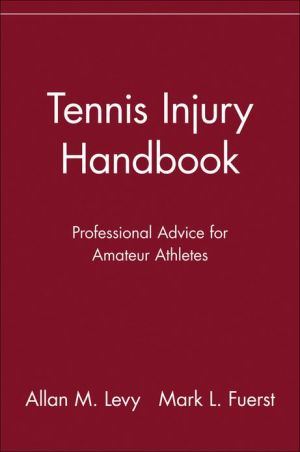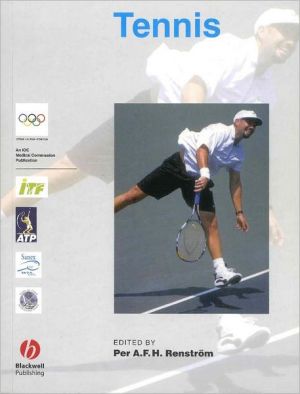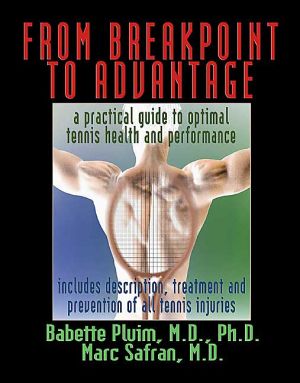Tennis Injury Handbook: Professional Advice to Amateur Athletes
A very comprehensive and well-written book about the most common tennis injuries. I certainly wish something like this had been available 25 years ago.—Fred Stolle, member of the International Tennis Hall of Fame.\ "Maintaining fitness is a high priority for people of all ages, especially those of us addicted to tennis. This book can help you improve not only your game but your quality of life as well."—David N. Dinkins, USTA and USPTR Board Member and former mayor of New York City.\ "It...
Search in google:
"A very comprehensive and well-written book about the most common tennis injuries. I certainly wish something like this had been available 25 years ago."—Fred Stolle, member of the International Tennis Hall of Fame. "Maintaining fitness is a high priority for people of all ages, especially those of us addicted to tennis. This book can help you improve not only your game but your quality of life as well."—David N. Dinkins, USTA and USPTR Board Member and former mayor of New York City. "It would be hard to find a more comprehensive or comprehensible guide to preparing for tennis play, not to mention preventing and treating tennis injuries. Every tennis player—beginning, intermediate, and advanced—could benefit from Dr. Levy's and Mark Fuerst's efforts."—Shimon-Craig Van Collie, author of Tennis: The Lifetime Sport. From the authors of the classic Sports Injury Handbook, this top-notch manual of easy-to-follow tennis do's and don'ts is all you need to prevent injuries, treat common symptoms, and improve your conditioning, flexibility, and strength, so you can pick up the pace on your serve or unload a return that won't come back. Dr. Allan Levy's practical knowledge of tennis fitness is indispensable for players at every skill level—from absolute beginners to club champions. Developed from his own experience treating recreational and professional tennis players, Dr. Levy's program features refreshingly simple stretches and exercises you can do on or off the court. For ease of use, the main part of the book is organized by area of the body. You'll learn how to recognize and treat injuries and determine when it issafe to play again. Packed with clear illustrations and practical advice, the Tennis Injury Handbook features: * Specific training ideas to improve your game and prevent injuries. * Easy-to-follow techniques for stretching, conditioning, and rehabilitation. * Expert advice on what foods to eat before, during, and after playing. * The pluses and minuses of a variety of tennis gadgets on the market. * A complete guide to tennis injuries from head to toe—how to recognize them and how to heal them. W. Ben Kibler This book provides advice on medical conditions and sports performance issues for tennis players. The many illustrations allow understanding of the points discussed and symbols with each topic alert the player to the severity of the condition and who should be consulted for care. This book helps to fill a relative void in the lay literature about tennis injuries. This is a good effort at achieving a high goal—good medical information is presented in a lay format. This book is written for the 20 million Americans who play tennis and need good information to play optimally with low injury risk. The primary author is well known in clinical sports medicine, and has written other books in the same vein. The strengths of this book lie in presenting a broad view of all the sports-related aspects of tennis—injuries, medical conditions, performance issues, therapy, alternative therapy, nutrition, and prevention. The guide symbols are helpful to decide severity and referral. The large number of illustrations makes the exercises understandable. The premise is to use common sense and prevent injuries. The major weaknesses of this book occur when, in trying to simplify injuries, the authors either oversimplify or misrepresent the problem. Examples of oversimplification include limited (and imperfectly illustrated) stretching for the posterior shoulder, isolated rotator cuff exercises for rotator cuff injury, minimal ligamentous contribution to shoulder stability, elbow braces helping to prevent tennis elbow, and stating that all patellofemoral pain is due to foot malalignment. Examples of misrepresentations include impingement of the short head of the biceps and nerves as asource of rotator cuff symptoms, stretching out of affected rotator cuff muscles, producing instability and/or rotator cuff symptoms, and the popliteal muscle being involved in tennis leg (which in itself is a poor term). There is a need in the lay literature for a complete book of this nature. This book illustrates the possibilities and difficulties inherent in such a book. Correction of oversimplification and misrepresentation, added to the positive structure of this book, may fill this need.
List of ExercisesForewordAcknowledgmentsIntroduction1Pt. 1Preparing to Play51Work Out to Win72Eat to Compete35Pt. 2Common Risks and Basic Safeguards433First Aid: What to Do until the Doctor Comes454Medical Risks515Health Gadgets61Pt. 3What to Know from Head to Toe676The Head and Neck697The Shoulder768The Back and Ribs879The Elbow9710The Wrist and Hand10711The Thigh and Hip11612The Knee12213The Lower Leg13114The Ankle13915The Foot145Pt. 4Tennis for Everyone15516The Senior Game15717Women in Tennis16518The Junior Player174Index181
\ From The CriticsReviewer: W. Ben Kibler, MD(Lexington Sports Medicine Center)\ Description: This book provides advice on medical conditions and sports performance issues for tennis players. The many illustrations allow understanding of the points discussed and symbols with each topic alert the player to the severity of the condition and who should be consulted for care.\ Purpose: This book helps to fill a relative void in the lay literature about tennis injuries. This is a good effort at achieving a high goal — good medical information is presented in a lay format. \ Audience: This book is written for the 20 million Americans who play tennis and need good information to play optimally with low injury risk. The primary author is well known in clinical sports medicine, and has written other books in the same vein.\ Features: The strengths of this book lie in presenting a broad view of all the sports-related aspects of tennis — injuries, medical conditions, performance issues, therapy, alternative therapy, nutrition, and prevention. The guide symbols are helpful to decide severity and referral. The large number of illustrations makes the exercises understandable. The premise is to use common sense and prevent injuries. The major weaknesses of this book occur when, in trying to simplify injuries, the authors either oversimplify or misrepresent the problem. Examples of oversimplification include limited (and imperfectly illustrated) stretching for the posterior shoulder, isolated rotator cuff exercises for rotator cuff injury, minimal ligamentous contribution to shoulder stability, elbow braces helping to prevent tennis elbow, and stating that all patellofemoral pain is due to foot malalignment. Examples of misrepresentations include impingement of the short head of the biceps and nerves as a source of rotator cuff symptoms, stretching out of affected rotator cuff muscles, producing instability and/or rotator cuff symptoms, and the popliteal muscle being involved in tennis leg (which in itself is a poor term).\ Assessment: There is a need in the lay literature for a complete book of this nature. This book illustrates the possibilities and difficulties inherent in such a book. Correction of oversimplification and misrepresentation, added to the positive structure of this book, may fill this need.\ \ \ \ \ W. Ben KiblerThis book provides advice on medical conditions and sports performance issues for tennis players. The many illustrations allow understanding of the points discussed and symbols with each topic alert the player to the severity of the condition and who should be consulted for care. This book helps to fill a relative void in the lay literature about tennis injuries. This is a good effort at achieving a high goal—good medical information is presented in a lay format. This book is written for the 20 million Americans who play tennis and need good information to play optimally with low injury risk. The primary author is well known in clinical sports medicine, and has written other books in the same vein. The strengths of this book lie in presenting a broad view of all the sports-related aspects of tennis—injuries, medical conditions, performance issues, therapy, alternative therapy, nutrition, and prevention. The guide symbols are helpful to decide severity and referral. The large number of illustrations makes the exercises understandable. The premise is to use common sense and prevent injuries. The major weaknesses of this book occur when, in trying to simplify injuries, the authors either oversimplify or misrepresent the problem. Examples of oversimplification include limited (and imperfectly illustrated) stretching for the posterior shoulder, isolated rotator cuff exercises for rotator cuff injury, minimal ligamentous contribution to shoulder stability, elbow braces helping to prevent tennis elbow, and stating that all patellofemoral pain is due to foot malalignment. Examples of misrepresentations include impingement of the short head of the biceps and nerves as asource of rotator cuff symptoms, stretching out of affected rotator cuff muscles, producing instability and/or rotator cuff symptoms, and the popliteal muscle being involved in tennis leg (which in itself is a poor term). There is a need in the lay literature for a complete book of this nature. This book illustrates the possibilities and difficulties inherent in such a book. Correction of oversimplification and misrepresentation, added to the positive structure of this book, may fill this need.\ \ \ 3 Stars from Doody\ \



